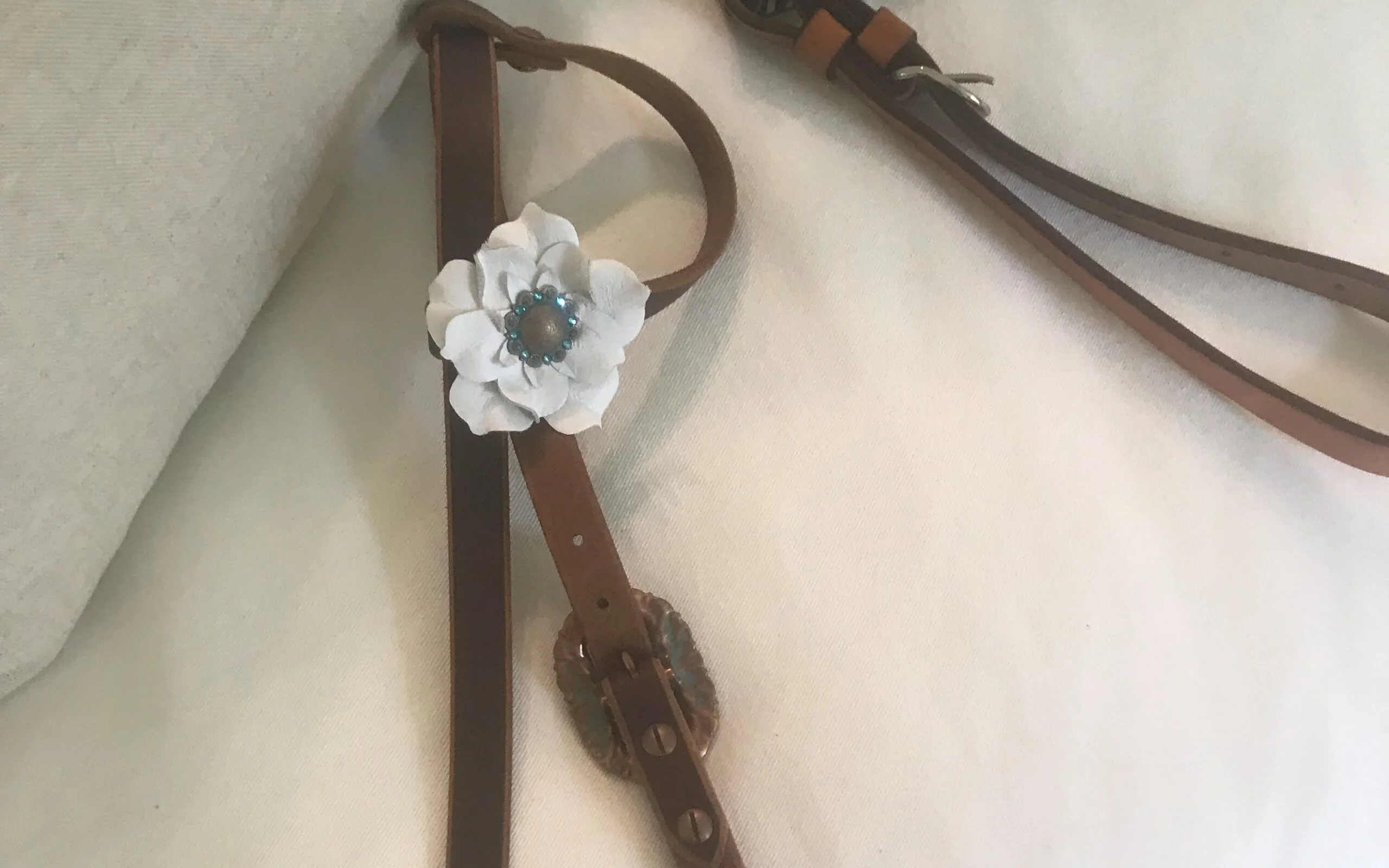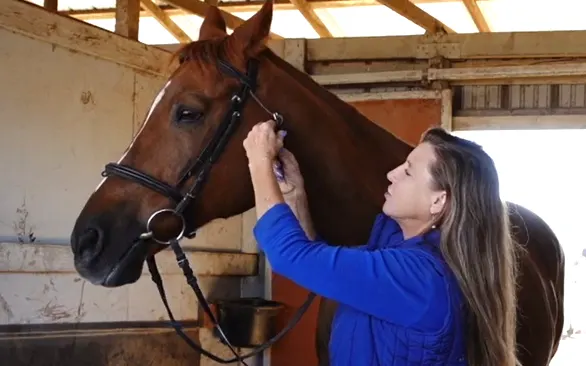Last updated: June 29, 2023
Any links on this page that lead to products on Amazon are affiliate links and I earn a commission if you make a purchase. Thanks in advance – I really appreciate it!
A young girl who visits our barn loves horses and asking questions. One day, she wanted to know what the difference was between a headstall and a bridle. My grandson told her they were equipment used to steer a horse- which isn’t exactly correct because there is more to it than this.
A headstall is the part of the bridle that goes around your horse’s head. It attaches to the bit and reins and helps keep everything in place. In English riding, you have a browband, and for Western riding, one ear is common. These attach to the headstall to keep the bridle slipping backward.
Having the proper equipment is key to a successful and safe ride. One of the most important pieces of gear is the headstall, which keeps your horse’s bit in place. In this comprehensive guide, we’ll walk you through all the different types of headstalls and how to choose the right one for you and your horse.

What Is A Headstall For Horses?
As an important component of any bridle, finding the right headstall for your horse is essential, as the bridle is the primary communication tool with your horse. But headstall is a broad term and can come in various forms and styles, but in the end, they all execute the same function.
A headstall for horses is a strap that goes over the horse’s head behind the ears at the poll joint or crown. This part allows the bridle to hang on the horse’s head and attaches all the relevant details to the bit needed to communicate with your horse through the reins.
Headstalls can come in different materials, from synthetic, nylon, rope, and the most popular being leather. There are various designs of headstalls from the English traditional plain headstall, a band with two loose straps on either side to allow the cheek pieces to connect to the bit, and a thinner strap called the throatlatch.
Then there is the western headstall that hangs over the crown and links to the bit with a one-ear loop. Then the term halter is used for everything else but riding; this item is purely used to lead or restrain the horse in cross ties when grooming him and for when you go to catch him in the field.

What’s The Difference Between A Bridle And Headstall?
A bridle is a horse riding equipment used on the horse’s head to communicate direction and transmit hand commands to the horse through reins attached to the bit. A bridle is made of several elements that connect to form the bridle as a whole.
- Headstall
- Browband
- Cheekpeices
- Throatlatch
- Noseband
- Reins
- Bit
The headstall is one of the elements which attaches the cheek pieces connecting to the bit, with a browband or one ear to prevent the strap from slipping backward. Or a headstall may be the head collar used for groundwork with your horse, from leading the horse, grooming him to loading them into the horse box for traveling.

What Is The Point Of A One-Ear Headstall?
In Western riding, a headstall may have a loop that goes around one ear of the horse, hence the name. This ear loop helps prevent the headstall from slipping down the horse’s neck, similar to a browband in English riding bridles.
Headstalls can have different styles of earpieces
Western show-style bridles are simplistic, there is no throatlatch preventing the bridle from slipping over the ears, and they only have a one-ear attached to the headstall. It is great for those sensitive horses irritated by the traditional browband and nosebands. These are more stylistic bridles and should not be used with green or unruly horses.
Apart from being a fashion preference to spruce up bridles, choosing a one-ear also depends on what style of bit you are using. If you look at the action of the reins on a leverage bit with a shank in western bridles, you will see that the movement of the reins on the bit creates a downward motion of the headstall that reduces the risk of the headstall slipping off the horse’s crown.
The risk of the horse shaking its head or an incorrectly fitting bridle may cause the headstall to slip off due to the lack of a throatlatch. The added ear slip will help prevent the bridle from falling straight off the horse for a few minutes while you gather up again.

How Do I Choose A Headstall?
Headstalls on a bridle all have the same function, they are a component that completes the bridle, but there are still some points to consider when choosing a headstall.
Style Of Riding, Western Or English
Although headstalls perform the same function on any bridle, there is still a difference between the Western and the English headstall. Headstalls come in three general styles.
- Browband with throatlatch is the most secure form of headstall for a bridle, which is used in English or Western riding.
- One-ear is a plain headstall with no throatlatch and a loop around one ear, used in western riding.
- The split ear headstall is another style that is used in Western riding. The headstall band is split in the middle, and the ears of the horse are positioned between the two straps.
Let’s face it, horses are pretty smart, and once they figure out how to get rid of something that bugs them, they will continue doing it.

What Bits You Use
Again, the browband and throatlatch piece can be used with any bit from a snaffle to a curb bit and will sit securely. On the other hand, the one-ear or split-ear headstall is not recommended to be used with snaffle bits. When you pull the reins up with a snaffle bit, the action creates slackness in the cheekpieces allowing the headstall to loosen over the poll, and with no throatlatch securing the bridle on the horse head, it could easily slip off if your horse throws its head around.
Also, Listen To Your Horse
Some horses can be susceptible to browbands or headstalls. Some have pressure sensitivity on their poll, so any headstalls with cut-back ears or padding in English-style bridles are not uncommon to find.
Listening to your horse and understanding when something irritates him will help you determine which headstall is best for them. Also, check that the bridle fit is correctly adjusted, positioned, and fits your horse properly.
A one-ear can be used for horses with a very wide forehead or when they are sensitive to the pressure where the browband is too tight across their heads. In my opinion, if you are looking for a headstall that is functional for any event and that is the safest to use on a horse, then in my experience, the browband with a throatlatch is the best to use, allowing you to use it from leisure to competition providing that extra added peace of mind that your bridle will still be there when you gather up the reins.

Conclusion
A headstall forms an integral part of the bridle or halter and is the strap that goes around the horse’s head at its crown just behind the ears to secure and bridle or halter to the horse. There are different styles of headstalls that you can choose from, but apart from fashionable preferences, there are some excellent reasons why you would choose one over the other.
Below is a helpful YouTube video showing you tips on how to put together your headstall.
FAQs
What’s the difference between a bridle and a Headstall?
The headstall is the part of the bridle that goes around the horse’s head. It’s usually made of leather or nylon and has a buckle so you can adjust it to fit your horse’s head. The bridle is made up of the headstall, reins, and bit.
Can you put a bridle over a halter?
Yes, you can put a bridle over a halter. However, this is typically only done when working with young horses or inexperienced riders. Having the halter on allows you to easily attach a lead rope if needed.
References
- https://www.cowboyway.com/What/Headstalls.htm
- https://en.wikipedia.org/wiki/Bridle
- https://afs.ca.uky.edu/files/western_bridles.pdf
- https://www.sstack.com/one-ear-split-ear-headstalls/c/3120/#:~:text=What%20is%20a%20one%20ear,browband%20does%20on%20English%20bridles.
- https://wikidiff.com/bridle/headstall
Meet Miles Henry
An avid equestrian and seasoned racehorse owner, Miles Henry brings his extensive experience to the equine world, proudly associating with the AQHA, The Jockey Club, and various other equine organizations. Beyond the racetrack, Miles is an accomplished author, having published various books about horses, and is a recognized authority in the field, with his work cited in multiple publications.
🔗 Connect with Miles:
Twitter
Facebook
YouTube: Check out race highlights, horse care tips, and more!

